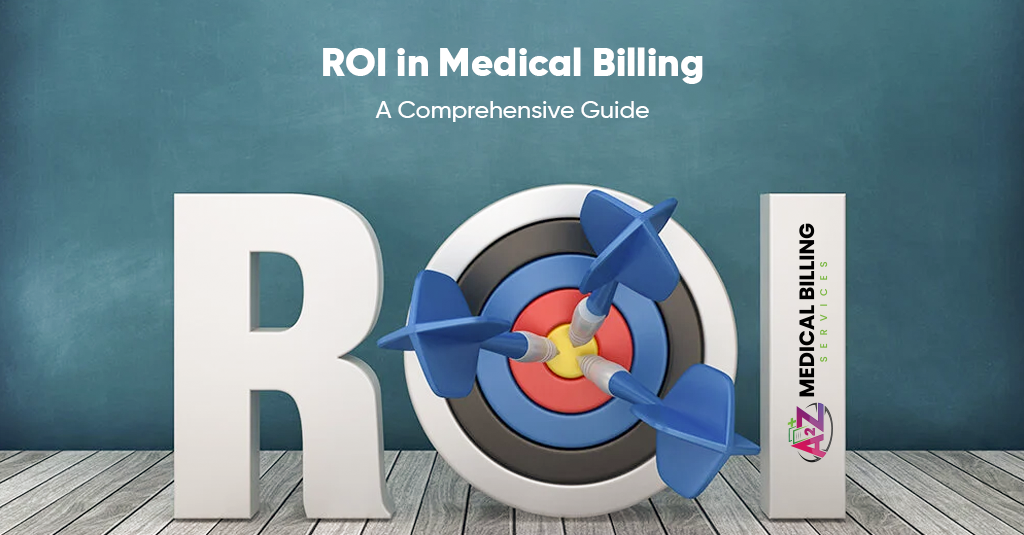If you run a medical practice, you’ve probably felt this: you’re treating more patients than ever, but your collections somehow don’t match your workload. The numbers don’t add up.
That’s where ROI (Return on Investment) comes in — not as a fancy finance term, but as a practical way to measure whether your medical billing process is helping your practice grow or quietly draining your profits.
In healthcare, ROI isn’t just about “how much money came in.” It’s also about how efficiently you’re running, how fast you get paid, and how much clinical time you reclaim by fixing your billing chaos. Let’s break this down step by step and show you exactly how to measure, track, and improve your medical billing ROI — without needing a finance degree.
What ROI in Medical Billing?

ROI stands for Return on Investment, and in healthcare billing, it measures the value your billing system or service brings to your practice compared to its Cost.
It’s not just about whether you’re getting paid — it’s about how effectively your billing system converts patient visits into revenue, how much time it saves your staff, and whether it helps your practice grow instead of dragging it down with denials and delays.
The basic formula looks like this:
ROI = (Gain from investment − Cost of investment) ÷ Cost of investment
In billing terms, your investment might be:
- Hiring and training in-house billers
- Paying for billing software or clearinghouse fees
- Outsourcing to a professional medical billing company
- Adding automation or AI tools for claim scrubbing or payment posting
Your gain is what you get in return:
- Higher collections
- Fewer denials
- Faster payments
- Reduced staffing costs
- More time to see patients
For example:
If you spend $100,000 a year running your billing department and it helps you collect $300,000, your ROI is (300,000 − 100,000) ÷ 100,000 = 200%.
That means for every dollar you invest in billing, you get $2 back.
But here’s the twist: in healthcare, ROI isn’t just about dollars. It’s also about saving time, reducing stress, and retaining patients because your billing runs smoothly. Those “soft” returns matter just as much as the financial ones.
Financial ROI (Hard Dollar Returns)
Financial ROI in medical billing measures the direct monetary benefits — the real dollars your practice gains through improved revenue cycle performance. This includes higher reimbursement rates, faster payments, fewer denials, and lower overhead costs. For instance, a family medicine clinic that upgraded its billing system reduced its denial rate from 10% to 4%, which boosted collections by nearly $90,000 in one year. That’s a direct, measurable financial return showing how effective billing can turn lost revenue into profit.
Non-Financial ROI (Qualitative but Measurable Benefits)
Non-financial ROI captures the improvements that don’t always show up on your balance sheet but still have immense business value — like staff efficiency, patient satisfaction, and reduced administrative burnout. For example, an orthopedic group that outsourced billing cut its front-office workload by 30%, allowing staff to focus on patient engagement instead of claim follow-ups. The result? Happier employees, better patient experiences, and fewer billing complaints — all of which strengthen the practice’s reputation and long-term stability.
Key Metrics That Drive ROI in Medical Billing
ROI isn’t just about what you earn — it’s about how efficiently your billing system converts your work into revenue. To measure that, you need to track specific metrics that show how healthy your revenue cycle really is.
Let’s break down the most important ones — and why they matter more than most practices realize.
Net Collection Rate (NCR)
Your Net Collection Rate tells you how much of your collectible revenue you’re actually collecting after adjustments and write-offs.
In simple terms, it’s your “real collection efficiency.”
A strong NCR (typically above 95%) means your billing process is doing its job — clean claims, solid follow-ups, and minimal revenue leakage.
A low NCR, however, often hides deeper problems: undercoding, poor follow-ups, or high write-offs.
Example: If your practice bills $1,000,000 but collects only $870,000 after adjustments, your NCR is 87%. That missing 13% is pure lost revenue — and improving it could mean a $130,000 boost to your annual collections.
Days in Accounts Receivable (Days in AR)
This metric measures how long it takes, on average, for your practice to get paid after submitting a claim.
The shorter the AR days, the better your cash flow.
Most efficient practices stay under 30 days, while anything beyond 45 days indicates delays or payer issues.
Example: A multi-specialty group reduced its AR from 47 to 28 days by tightening claim scrubbing and automating payment posting — freeing up enough cash flow to expand services without loans.
Initial Claim Denial Rate / First-Pass Acceptance Rate
These two are flip sides of the same coin.
The denial rate shows how many claims are rejected on the first submission, while first-pass acceptance shows how many get approved right away.
The industry average first-pass rate is around 85–88%.
Top-performing billing systems push that number up to 97–99% — and every percentage point gained means faster reimbursements and fewer staff hours wasted on rework.
Example: A dermatology clinic improved its first-pass rate from 89% to 98% after implementing better pre-authorization checks — cutting denials in half and recovering roughly $60,000 in delayed revenue within six months.
Cost to Collect (Per Claim or % of Collections)
This metric tells you how much it costs to collect each dollar of revenue. It includes billing staff salaries, software, claim edits, follow-ups, and vendor fees.
Ideally, your Cost to collect should stay below 5% of total collections.
If it’s higher, it means inefficiencies — too much manual work, outdated systems, or low claim success rates.
Example: An internal medicine practice discovered that their in-house billing cost them 9% of collections due to staff overtime and errors. After outsourcing, their Cost dropped to 4.2% — saving nearly $50,000 annually.
Clean Claim Rate
A “clean claim” gets accepted and paid without corrections or resubmissions.
This metric is a powerful predictor of both revenue speed and billing quality.
A strong, clean claim rate (above 95%) means your team is submitting complete, accurate, and properly coded claims the first time around.
Anything lower usually signals poor documentation or eligibility issues.
Example: A pediatric group raised its clean claim rate from 88% to 97% by improving documentation templates in their EHR — reducing rework time and speeding up payments by two weeks.
A/R Over 90 Days
This shows the percentage of outstanding claims sitting in your Accounts Receivable for more than 90 days — basically, the “stuck money.”
You want this number below 10%.
If more than that is over 90 days old, you’re likely facing systemic issues like delayed follow-ups or payer underpayments.
Example: A urology clinic saw that 22% of their A/R was past 90 days. After implementing a weekly A/R audit and follow-up tracker, they cut that number to 8% within a quarter — unlocking $75,000 in old claims.
Reimbursement per Visit / CPT Mix Impact
Not all visits are created equal — and not all CPT codes reimburse the same.
Tracking your average reimbursement per visit helps you understand if your coding, payer contracts, or patient mix are affecting revenue potential.
Example: An orthopedic practice analyzed its CPT mix and realized post-op follow-ups were dominating visits while higher-paying procedures were underrepresented. By adjusting scheduling and coding focus, they increased average reimbursement per visit by 12% in just three months.
Common Investment Types: What You Should Count?
Before you calculate ROI, you need to know what’s included in your investment. Many practices underestimate how much they actually spend on billing operations. Every dollar and every hour matters. Here’s what you should count.
Staffing
Your billing team’s salaries, benefits, and training costs form the most considerable portion of in-house billing investment.
This includes billers, coders, AR follow-up specialists, and sometimes even your front desk staff handling prior authorizations.
If staff turnover is high, add recruiting and retraining costs too — they quietly eat into ROI.
Outsourcing Fees
If you work with a medical billing company, this becomes your direct investment.
These fees often range between 4% and 7% of collections, depending on specialty and claim volume.
Don’t forget to include onboarding, data migration, and any setup fees. The goal is to compare these costs against how much new revenue or time savings they bring.
Technology
Every billing process depends on software — your EHR, practice management system, clearinghouse, or RCM tools.
Licensing fees, upgrades, integrations, and even IT support all count as technology investments.
For example, if an AI-based claim scrubber improves your clean claim rate from 90% to 98%, that’s a measurable tech-driven ROI.
Process Change
Sometimes, ROI comes from redesigning workflows — updating documentation, improving charge capture, or automating eligibility verification.
These changes often cost time, training hours, and short-term productivity dips — all worth including in your investment total.
Risk and Penalty Costs
This one’s often overlooked. Billing errors, compliance gaps, or audit penalties are “negative investments.”
Reducing risk and avoiding penalties directly improves ROI — even if it’s hard to quantify upfront.
Think of it as money you don’t lose because your billing system works right.
How to Calculate ROI — Step-by-Step

ROI in medical billing isn’t a mysterious formula — it’s just a disciplined measurement.
Here’s how you can calculate the ROI in healthcare.
Step 1: Identify Your Costs
Add up all your investments from the list above — staffing, outsourcing, software, training, etc.
Example:
- Billing software + staff = $100,000/year
Step 2: Measure Financial Returns
Calculate the total increase in collections or savings after the investment.
Example:
- Collections improved from $1,000,000 → $1,200,000 = $200,000 gain
Step 3: Apply the Formula
ROI = (Gain – Cost) ÷ Cost × 100
Using the example above:
ROI = ($200,000 – $100,000) ÷ $100,000 × 100 = 100% ROI
That means you earned $2 for every $1 spent on billing improvements.
Step 4: Include Non-Financial Gains
Add measurable qualitative returns — time saved, fewer denials, improved patient satisfaction — even if you track them as separate performance indicators.
The whole picture is what drives more thoughtful business decisions.
How to Improve ROI?
Once you know your ROI baseline, the next step is to improve it. Small operational changes can dramatically increase your returns.
Automate What’s Repetitive: Eligibility checks, payment posting, and claim scrubbing are low-hanging fruit. Automation reduces manual errors and boosts clean claim rates — directly improving cash flow.
Strengthen Front-End Accuracy: Most billing errors start before claims are even submitted.
- Train staff to verify patient data, insurance eligibility, and authorization before the visit.
- Fixing errors at the source increases your first-pass acceptance and lowers denial costs.
Monitor KPIs Monthly: Track your key metrics — NCR, AR days, denial rate, and cost to collect — every month. If one metric trends down, fix it before it becomes a full-blown revenue problem.
Re-Negotiate with Payers: Outdated payer contracts can drain revenue. Review fee schedules annually and benchmark reimbursement rates per CPT code. Even a 3% improvement in contracted rates can create significant ROI over the year.
Outsource Strategically: Outsourcing doesn’t just cut costs — it often increases revenue. Professional billing teams use analytics and denial management strategies that most small practices can’t match internally. If your in-house billing ROI has plateaued, outsourcing may double your returns.
Implementation Plan for Measuring ROI (A Practical How-To)
Measuring ROI isn’t a one-time project — it’s a continuous process. Here’s a simple implementation plan your practice can follow.
Baseline Capture (30 Days)
Spend one month tracking your current performance: NCR, AR days, denial rate, and cost to collect. This becomes your “before” snapshot.
Pilot Phase
Introduce a specific change — like a new billing partner, software, or workflow — for one department or location. Keep it contained so you can measure cause and effect clearly.
Measure Monthly
Track the same metrics every month. Compare them to your baseline. Are denials dropping? Is AR faster? Are collections up?
Calculate Rolling 12-Month ROI
After 12 months, calculate your total ROI using the full-year data. This smooths out short-term spikes and gives you an accurate picture of performance.
Scale
Once the pilot proves successful, roll the strategy out practice-wide. Document your learnings, standardize the process, and keep measuring ROI every quarter.
ROI Risks — And How to Avoid Them
Even the best ROI plan can fall apart if you miss a few common traps along the way. The good news? Most of these mistakes are easy to prevent once you know what to look for.
Here’s what can derail your medical billing ROI — and how to stay ahead of it:
Ignoring Hidden Costs
Many practices forget about indirect expenses like staff training, downtime during software transitions, or setup costs.
Avoid it: Track every expense, not just vendor fees. Include time costs, temporary productivity dips, and support fees in your ROI math.
Focusing Only on Revenue
More revenue doesn’t automatically mean higher ROI. If your operating costs rise faster, your margins still shrink.
Avoid it: Measure both revenue and expenses monthly. Watch for creeping overhead or overtime that eats into profits.
Overlooking Non-Financial Gains
If you only measure dollars, you’ll miss the softer wins — like staff morale, reduced burnout, and happier patients.
Avoid it: Add qualitative metrics such as patient satisfaction, claim turnaround speed, and staff retention to your ROI dashboard.
Lack of Consistent Measurement
ROI isn’t a one-time calculation. Without consistent tracking, you’ll lose sight of what’s improving or slipping.
Avoid it: Set up monthly performance reviews using the same KPIs (NCR, AR days, denial rate, etc.) to see real trends, not guesses.
Poor Change Management
Even smart investments fail when your team isn’t trained or aligned. Resistance or confusion during rollout can delay results.
Avoid it: Communicate early, train well, and involve your staff in process updates. When the team understands the “why,” they deliver the “results.”
Final Thoughts
ROI isn’t just a number — it’s your financial health indicator.
It tells you how well your billing investments are working, how efficiently your revenue flows, and how sustainable your practice really is.
The truth is, most practices don’t need more patients.
They need a smarter billing strategy that recovers what they’ve already earned.
Start simple:
- Measure your KPIs.
- Identify leaks.
- Track ROI quarterly.
- Improve one metric at a time.
In six months, you’ll know exactly where your money is going — and how much more of it could be coming back.
Stop Letting Inefficiencies Eat Your Revenue.
If you’re a provider tired of guessing what’s happening with your revenue, it’s time to take control.
ROI isn’t just a financial tool — it’s your roadmap to a healthier, more profitable practice.
Your next billing cycle could be your most profitable one yet.
Start measuring. Start improving.
Frequently Asked Questions (FAQs) About ROI in Medical Billing
1. What is a good ROI for medical billing services?
A good ROI for medical billing services typically ranges between 150% and 300%, depending on the size and specialty of the practice.
That means for every dollar invested in billing — whether through in-house operations or outsourcing — a strong system should generate $1.50 to $3.00 in return.
Practices with optimized revenue cycle management, low denial rates, and automated billing processes often achieve ROI levels above 250%.
2. How can healthcare providers measure ROI in billing?
Healthcare providers can measure ROI in billing using the formula:
ROI = (Gain from Investment − Cost of Investment) ÷ Cost of Investment × 100
To calculate it accurately, track:
- Total collections before and after billing improvements
- Operational costs, including staff, software, and outsourcing fees
- Key RCM metrics, such as net collection rate, denial rate, and AR days
By comparing increased revenue and reduced costs, providers can determine how efficiently their billing process converts work into profit.
3. What are common billing metrics that affect ROI?
The most important medical billing metrics that influence ROI include:
- Net Collection Rate (NCR): Measures how much collectible revenue is actually received.
- Days in Accounts Receivable (AR): Shows how long it takes to get paid.
- First-Pass Acceptance Rate: Indicates how many claims are approved on the first submission.
- Cost to Collect: The total cost of collecting each dollar of revenue.
- A/R Over 90 Days: Reveals how much money is stuck in long-term outstanding claims.
Improving these metrics directly increases cash flow, reduces operational costs, and boosts overall ROI.
4. Is outsourcing medical billing better for ROI?
Yes — in most cases, outsourcing medical billing leads to a higher ROI compared to managing billing in-house.
Professional billing companies have specialized teams, automation tools, and payer relationships that reduce denials, speed up reimbursements, and lower administrative costs.
Many practices see ROI improvements of 50–100% within the first year after outsourcing.
5. How often should a practice measure its billing ROI?
Ideally, practices should measure billing ROI quarterly, with a full evaluation annually.
Frequent measurement helps identify trends early — such as rising AR days or denial spikes — so issues can be fixed before they impact revenue.
Tracking ROI over time ensures your billing system remains efficient and financially healthy.



